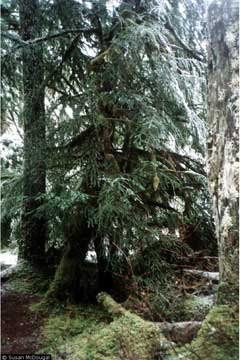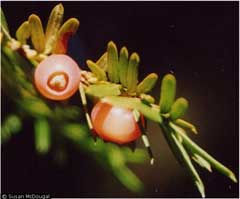 |
|
Susan McDougall @ USDA-NRCS PLANTS Database |
 |
| Susan McDougall @ USDA-NRCS PLANTS Database |
Translate this page:
Summary
Physical Characteristics

 Taxus_brevifolia is an evergreen Tree growing to 15 m (49ft 3in) at a slow rate.
Taxus_brevifolia is an evergreen Tree growing to 15 m (49ft 3in) at a slow rate.
See above for USDA hardiness. It is hardy to UK zone 6 and is not frost tender. It is in leaf all year, in flower from March to May, and the seeds ripen from September to November. The species is dioecious (individual flowers are either male or female, but only one sex is to be found on any one plant so both male and female plants must be grown if seed is required). and is pollinated by Wind. The plant is not self-fertile.
Suitable for: light (sandy), medium (loamy) and heavy (clay) soils and prefers well-drained soil. Suitable pH: mildly acid, neutral and basic (mildly alkaline) soils and can grow in very acid and very alkaline soils.
It can grow in full shade (deep woodland) semi-shade (light woodland) or no shade. It prefers dry or moist soil. The plant can tolerates strong winds but not maritime exposure.
It can tolerate atmospheric pollution.
UK Hardiness Map
US Hardiness Map
Synonyms
Taxus bourcieri Carrière. Taxus lindleyana A.Murray bis. Taxus occidentalis Nutt.
Plant Habitats
Edible Uses
Fruit - raw[105, 161, 257]. Very sweet and gelatinous, most people find it delicious though some find it sickly[K]. The fruit is a fleshy berry about 8mm in diameter and containing a single seed[200]. Trees usually produce good crops every year[229]. All other parts of this plant, including the seed, are highly poisonous. When eating the fruit you should spit out the large seed found in the fruit's centre. Should you swallow the whole seed it will just pass straight through you without harm, if the seed has been bitten into, however, it could cause some problems.
References More on Edible Uses
Medicinal Uses
Plants For A Future can not take any responsibility for any adverse effects from the use of plants. Always seek advice from a professional before using a plant medicinally.
The Pacific yew is a highly toxic plant but it was employed medicinally by several native North American Indian tribes who used it to treat a variety of complaints[257]. Modern research has shown that it contains the substance 'taxol' in its shoots and bark. Taxol has shown exciting potential as an anti-cancer drug, particularly in the treatment of ovarian cancers[238]. Unfortunately, the concentrations of taxol are rather low and the bark of 6 trees is required to provide enough taxol to treat one patient[238]. This remedy is very toxic and, even when used externally, should only be used under the supervision of a qualified practitioner[238]. See also the notes above on toxicity. All parts of the plant, except the fleshy fruit, are diaphoretic and pectoral[257]. A decoction of the branches and leaves has been used in the treatment of lung problems[257]. An infusion of the crushed leaves has been used externally as a wash to cause perspiration and effect a general improvement in the health[257]. A poultice of the crushed leaves has been applied to wounds[257]. A decoction of small woody pieces has been used in the treatment of internal complaints including stomach pains and blood in the urine[257]. The leaves are harvested in early autumn or spring, the bark from autumn to spring, for commercial extraction of taxol[238]. Ingestion of 50-100g of needles can cause death.
References More on Medicinal Uses
The Bookshop: Edible Plant Books
Our Latest books on Perennial Plants For Food Forests and Permaculture Gardens in paperback or digital formats.

Edible Tropical Plants
Food Forest Plants for Hotter Conditions: 250+ Plants For Tropical Food Forests & Permaculture Gardens.
More

Edible Temperate Plants
Plants for Your Food Forest: 500 Plants for Temperate Food Forests & Permaculture Gardens.
More

More Books
PFAF have eight books available in paperback and digital formats. Browse the shop for more information.
Shop Now
Other Uses
A red paint was made by mixing the woodchips with oil[226]. The roots have been used as the weft in twined basketry[257]. The root is very strong and is particularly good for hopper mortar baskets[257]. Wood - fine-grained, strong, hard, heavy, durable and resilient, taking a very fine polish. Though hard, the wood is easy to carve[226]. It is also used for making paddles, fence posts and various other small articles[46, 61, 82, 226, 229, 257].
Special Uses
References More on Other Uses
Cultivation details
Thrives in almost any soil, acid or alkaline, as long as it is well-drained[1, 200]. Succeeds in dry soils. Plants are very shade tolerant[81]. Dormant plants are very cold-hardy, though the young growth in spring can be damaged by late frosts. A slow-growing but apparently long-lived tree[229]. Plants produce very little fibrous root and should be planted in their final positions when still small[200]. Because of its useful wood, large trees are unscrupulously poached from the wild and, in some areas, the species has been nearly extirpated. Exploitation of the species for medicinal purposes is further threatening it in the wild[270].. Plants in this genus are notably resistant to honey fungus[200]. Dioecious. Male and female plants must be grown if seed is required.
References Carbon Farming Information and Carbon Sequestration Information
Temperature Converter
Type a value in the Celsius field to convert the value to Fahrenheit:
Fahrenheit:
The PFAF Bookshop
Plants For A Future have a number of books available in paperback and digital form. Book titles include Edible Plants, Edible Perennials, Edible Trees,Edible Shrubs, Woodland Gardening, and Temperate Food Forest Plants. Our new book is Food Forest Plants For Hotter Conditions (Tropical and Sub-Tropical).
Shop Now
Plant Propagation
Seed - can be very slow to germinate, often taking 2 or more years[78, 80]. It is best sown as soon as it is ripe in the autumn when it should germinate 18 months later. Stored seed may take 2 years or more to germinate. 4 months warm followed by 4 months cold stratification may help reduce the germination time[113]. Harvesting the seed 'green' (when fully developed but before it has dried on the plant) and then sowing it immediately has not been found to reduce the germination time because the inhibiting factors develop too early[80]. Prick out the seedlings into individual pots once they are large enough to handle and grow them on in pots in a cold frame. The seedlings are very slow-growing and will probably require at least 2 years of pot cultivation before being large enough to plant out. Any planting out is best done in late spring or early summer, after the last expected frosts[K]. Cuttings of half-ripe terminal shoots, 5 - 8cm long, July/August in a shaded frame. Should root by late September but leave them in the frame over winter and plant out in late spring[78]. High percentage[11]. Cuttings of ripe terminal shoots, taken in winter after a hard frost, in a shaded frame[113].
Other Names
If available other names are mentioned here
Native Range
NORTHERN AMERICA: United States (Alaska (south), Idaho, Montana, Oregon, Washington, California), Canada (Alberta, British Columbia)
Weed Potential
Right plant wrong place. We are currently updating this section.
Please note that a plant may be invasive in one area but may not in your area so it’s worth checking.
Conservation Status
IUCN Red List of Threatened Plants Status :

Growth: S = slow M = medium F = fast. Soil: L = light (sandy) M = medium H = heavy (clay). pH: A = acid N = neutral B = basic (alkaline). Shade: F = full shade S = semi-shade N = no shade. Moisture: D = dry M = Moist We = wet Wa = water.
Expert comment
Author
Nutt.
Botanical References
1182200
Links / References
For a list of references used on this page please go here
Readers comment